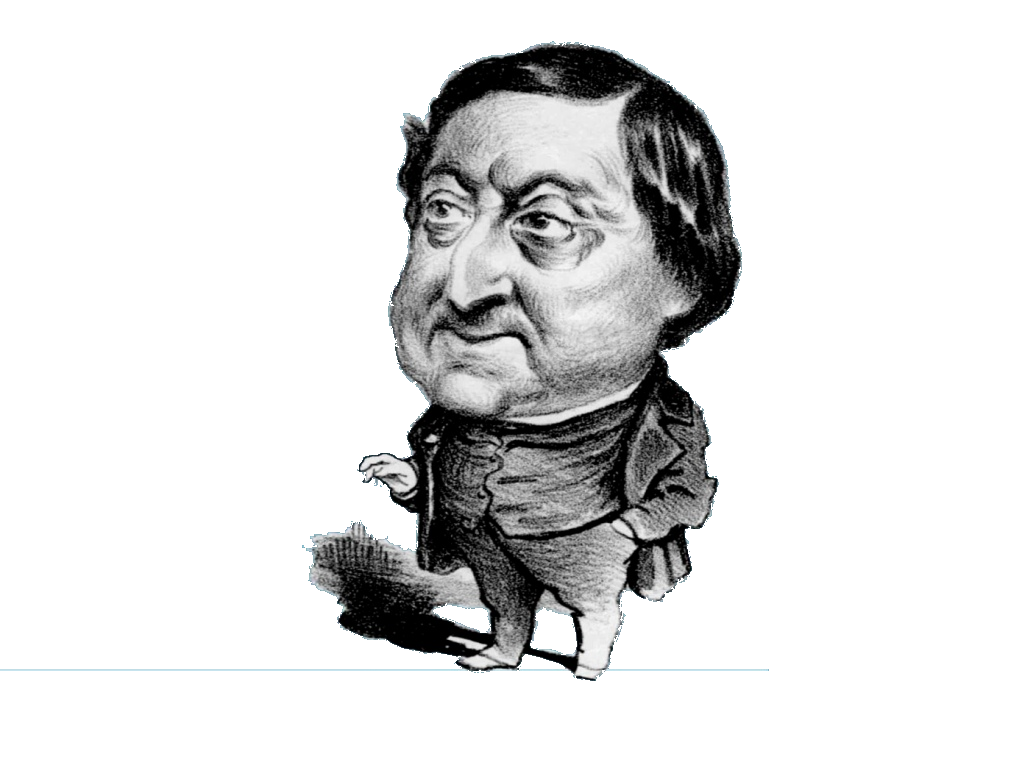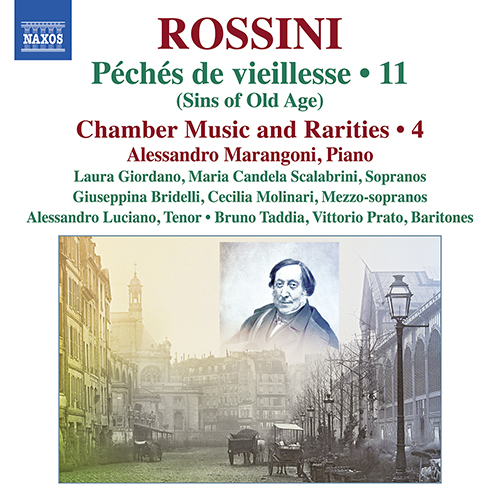|
The 20
pieces on this eleventh volume
round off this monumental
project to record all 200 or so
individual works comprising the
Péchés de vieillesse
(including some preliminary
sketches). The album includes
all the vocal duets, three
‘religious’ pieces and two
multi-sectional arrangements.
From now on, all titles and
quotations will follow Rossini’s
original orthography.
Among the 60 or so vocal works
in the Péchés de vieillesse,
there are only four duets which
Rossini included in the three
main vocal albums, all for
different forces. It is no
accident that Le Gittane
(Volume I, No. 6 [2]
) is an operatic piece. On 1
January 1861, Rossini dedicated
a transcript of it entitled Bolero
to Barbara and Carlotta
Marchisio ‘exclusively for their
personal use’, after the two
sisters had breathed new life
into his Semiramide
(1823) at the Paris Opéra in
1860. Rossini initially wrote
the melody, with its extensive
use of thirds, to Metastasio‘s
words Mi lagnerò tacendo
and then in the autograph score
wrote the Italian verse by
Giuseppe Torre directly
underneath. Soupirs et
Sourire (Nocturne) (Volume
II, No. 10 [3]
) is a French pendant to Torre’s
Italian ‘Notturno’ Il
Cipresso, e la Rosa
(ossia Allegrezza e
Melancolia), in which the
rose is a metaphor for joy, the
cypress tree for mourning, while
sighing and laughing juxtapose
the coquetry of the soprano with
the languishing of the tenor.
Rossini may only have
commissioned the translation by
Émilien Pacini to compensate for
the ‘excess’ of Italian pieces.
Un sou. Complainte a deux
Voix (Volume II, No. 4
[4] ) may also be a
setting of a text by Pacini,
though Rossini doesn’t give the
poet’s name. Although the
situation in the song, in which
the two beggars offer the collar
of their dead dog for sale, is
reminiscent of Offenbach’s bouffonnerie
musicale Les Deux aveugles
and is not without its funny
side, the duet is a typical
example of the alms song genre
that was so popular in
comfortable salons. Les
amants de Seville (Tirana,
pour deux voix) (Volume
III, No. 3 [10]
) may also have been based on
the usual text by Metastasio. It
is a ‘Tirana’ for two voices—a
song and dance form from
Andalusia whose main
characteristic is a refrain.
Rossini may have asked his house
poet for a ‘story’ with some
appropriate local colour, and
Pacini came up with a poem
featuring two lovers from the
area around Seville, the capital
of Andalusia, dating it ‘20
Avril 1864’.
As early as 1841 Richard Wagner
wrote: ‘Rossini is pious—the
world and his wife are pious,
and the Parisian salons have
turned into prayer cells.—It is
extraordinary! For as long as he
lives, this man will follow the
latest fashion. Does he set the
fashion trends, or do they
fashion him?’ Where sacred or
pious pieces were concerned, the
fashion was real and enduring
enough—this genre was as much a
staple of the salons as romantic
love songs or alms and begging
songs. As had been the case with
Adieux à la vie on one
note, the Ave Maria on
two notes (su due Note)
(Volume I, No. 7 [1]
) demonstrates an intensity of
expression that one wouldn’t
expect from such a ‘musical
joke’. The music fits the text
of Mi lagnerò tacendo
well, but it is not impossible
that Rossini composed the piece
to the words by Torre. The O
salutaris hostia from the
hymn by St Thomas Aquinas is a
true liturgical piece, though
Rossini’s original title, O
Salutaris, de Campagne (Volume
XI, No. 5 [12]
) establishes a ‘pastoral’
connection, the meaning of which
must remain a matter of
speculation. Perhaps it was
intended as a companion piece to
the ‘strict’ setting of the same
text as an unaccompanied vocal
quartet which Rossini had
composed in 1857 for Jacques
d’Ortigue’s periodical La
maîtrise. The reference in
his provisional catalogue of the
Péchés de vieillesse to
it being ‘taken from the Petite
Messe’ suggests that the piece
was originally composed for the
Petite Messe solennelle
and was only included in the
album later. Rossini’s
contemporaries did feel they
lacked one large-scale sacred
work penned by him: a Requiem
that might have been worthy of
replacing the customary Masses
for the Dead by Mozart or
Cherubini. Rossini did, however,
write a modest little Requiem,
without the pompous ‘Tuba
mirum’—A ma belle Mère
(Volume XI, No. 4 [11]
), to mark the death of his
mother-in-law, dated ‘Passy, 19
August 1859’. On 22 August 1859
he wrote to his friend Ivanoff:
‘We are saddened by the death of
my wife’s mother; she passed
away peacefully three days ago
at the age of 92.’ There is
therefore no lamentation, just
the hope that she will rest in
peace, which is emphasised
fervently at the words ‘et lux
perpetua luceat’.
Gammes (Volume III,
No. 5) play with the
so-called ‘Chinese scale’. First
come two pieces—(Montée)
(Pour Album) and (Descente)
[5] —comprising an
ascending and descending
chromatic scale, with the French
folk tune about Marlborough
appended to the ‘descent’. After
another chromatic ascent and
descent [6] comes the
first whole-tone scale (Ire
Gamme Chinoise montante et
Descendante [7]
) and then another (2me Gamme
Chinoise montante et
Descendante [8]
). These ‘exercises’ are
followed by L’Amour à Pèkin.
Petite Melodie sur La Gamme
Chinoise [9]
in which the contralto only uses
the six pitches of the ‘Chinese’
whole-tone scale within an
octave compass. Rossini sketched
out the text himself, Pacini
replacing it with the final
version about a Chinese woman’s
love for a soldier. The composer
dedicated the entire composition
to ‘my friend the millionaire M.
Jobart’, adding ‘Another joke’
to give his (thoroughly serious)
musical note-play a jocular
veneer.
Although Rossini was still
complaining about his health in
a letter dated 15 January 1857,
writing of ‘my terrible illness,
which is a nervous disorder (to
the disgrace of the [Medical]
Faculty), depriving me of sleep,
my appetite, my strength, etc.,
etc.’, he managed to go on a
kind of rejuvenating cure soon
afterwards. He had his furniture
transported from Florence to
Paris, rented a summer villa in
Passy, and composed the O
Salutaris hostia for
D’Ortigue and a virtuosic horn
piece for Eugène Vivier. The Frankfurter
Nachrichten of 10 June
1857 reported: ‘Rossini really
has been composing again. […]
After the great composer’s
health was restored, he was
drawn inexorably back to the
piano. Indeed, his friends even
noticed fresh manuscript paper
on his table. They quizzed
Rossini’s wife, and she
confirmed that her husband had
been writing music frequently
for a while already. After some
time had elapsed, Rossini did in
fact hand his wife an album of six
mélodies for
mezzo-soprano, preceded by a
pretty substantial prelude. He
had added a delightful
inscription on the title page of
the set.’ The report is largely
correct, even if Musique
Anodine is for a variety
of voice types. After the Prelude—Allegretto
moderato, for piano [13]
come N.° I (Pour Contralto)
[14] , N.° II (Pour
Baryton) [15]
, N.° III (Pour Soprano)
[16] , N.° IIII (Pour
Soprano) [17]
, N.° IIIII (Pour mezzo
Soprano) [18]
and N.° IIIIII (Pour
Baryton) [19] .
However, these were ‘only’ an
anthology of earlier pieces and
songs that he had revised. For
example, there is a version of
No. 6 dated 29 February 1852 in
the treble rather than the bass
clef. No. 5 even offers
an unusual example of Rossini
fitting Metastasio’s words to an
opera aria (Un’empia mel rapì
from Ermione, 1819). And
the composer had already
scribbled a motif that appears
in the Prelude on visiting cards
in 1856 in Bad Kissingen. The
collection’s ‘delightful
inscription’ reads: ‘Innocuous
music. / Prelude for piano /
followed by six little settings
of the same words […] These
unassuming songs are dedicated
to my darling wife Olympe as a
modest token of my gratitude for
her affectionate and clever
nursing during my long and
terrible illness (a cause of
shame to the [medical] Faculty).
/ Gioachino Rossini / Paris, 15
April 1857.’ Hunting for
original titles, which are as
much a hallmark of his mature
output as musical
experimentation, he lighted on
the bland yet ambiguous word
‘anodin’. On the one hand it is
used in medicine to describe a
tranquilliser (which can be
applied to music in general),
and on the other it means
‘harmless’, ‘innocuous’,
‘insignificant’, ‘characterless’
(which could refer to the
chameleonic interpretation of
the text). Rossini set one and
the same text, Mi lagnerò
tacendo from Metastasio’s
Siroe, in a whole variety of
ways, in the process both
pointing up and eroding its
sense in equal measure. Who is
it that is suffering in silence
and loving in quiet sorrow
without being loved in return
here? Is this a personal
statement or just verbal husks
on which to give his art as a
song composer a work-out?
Rossini may have felt that his
retirement from the operatic
stage in the 1830s was less a
personal decision than a blow of
fate about which he was
‘mourning in silence’ (‘The
Revolution in Paris […] has
ruined me as well’). The words
‘but, my love, do not hope /
that I shall stop loving you’
would then be directed to Music,
to which he was returning at the
end of his life with renewed
affection.
Rossini set his name to music as
early as 1822 in Addio a
Viennesi. In his old age
he occasionally set his entire
signature, ‘Gioachino Rossini’,
as in the version recorded here
[20] , dated, ‘Passy,
this 8 July 1863’). It is the
perfect piece to finish with,
setting a seal on this recording
of the complete ‘Sins of Old
Age’!
Reto Müller
Translation: Sue Baxter
|

